View in other NatureServe Network Field Guides
NatureServe
Montana
Utah
Wyoming
Idaho
Wisconsin
British Columbia
South Carolina
Yukon
California
New York
Meadow Slug - Deroceras laeve
Other Names:
Limax laevis, Limax campestris, Limax montanus, Limax castaneus, Limax hyperboreus, Limax hemphilli, Agriolimax montanus, Agriolimax campestris, Agriolimax hemphilli
Native Species
Global Rank:
G5
State Rank:
S4
Agency Status
USFWS:
USFS:
BLM:
External Links
General Description
A small slug, with individuals reaching about 25 mm extended, but often smaller. Base color is dark brown to blackish on the head, mantle and tail, sometimes with very small dark irregular spots. The mantle is oval, about 2/5 of the body length, has a series of concentric ridges somewhat like a fingerprint, and lacks a notch along the posterior margin. The pneumostome is posterior to the mantle cleft and on the right side. The tail is covered with a series of small furrows and elongated tubercles, and is slightly keeled near the posterior end. The sole is pale and tripartite (having two longitudinal furrows), the mucous is clear (McDonnell et al. 2009, Hendricks 2012, Burke 2013). Internal anatomy is described by Pilsbry (1948) and Forsyth (2004).
Diagnostic Characteristics
A combination of small size, lack of visceral mantle hump, concentric fingerprint-like ridges on the mantle, lack of notch in right posterior mantle margin, tripartite sole and unkeeled tail, and dark brown color separate this species from all others. Color, size, and production of clear mucous, even when disturbed, separate this species from the paler, mottled, and larger D. reticulatum.
Species Range
Montana Range
Range Descriptions
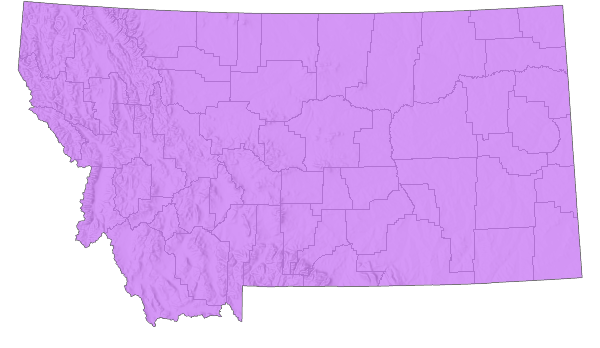
 Native
Native
Range Comments
Widespread throughout Europe, Asia, and the Americas. In Montana, recorded in 20 counties across the state, but likely occurring in every county. Elevation range is 674 to 2466 m (2210 to 8090 ft). Most populations at higher elevations in forested regions are probably native; many other populations, especially in valleys and towns, possibly occur as a result of inadvertent introductions. As many as 20 were found at one site in Madison County in early October (Hendricks 2012).
Observations in Montana Natural Heritage Program Database
Number of Observations: 99
(Click on the following maps and charts to see full sized version)
Map Help and Descriptions
Relative Density
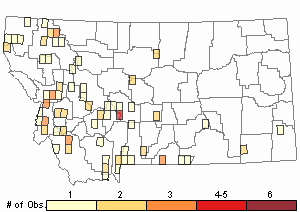
Recency
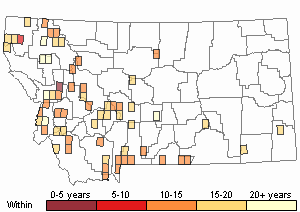
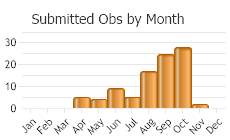
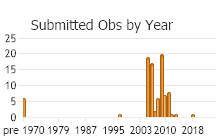
 (Observations spanning multiple months or years are excluded from time charts)
(Observations spanning multiple months or years are excluded from time charts)
Habitat
Found in a variety of situations near moisture (wet meadows, marshes, streamside riparian), sometimes in sites without a tree canopy. Canopy tree species include a mixture of conifer and broadleaf types, including Engelmann spruce, Douglas-fir, lodgepole pine, black cottonwood, aspen, paper birch, ponderosa pine, western larch, western redcedar, western hemlock, rocky mountain juniper, with a secondary canopy including alder, willow, dogwood, and hawthorn. Most often found under woody debris and leaf litter, sometimes under rocks (Hendricks 2012).
Stewardship Responsibility
References
- Literature Cited AboveLegend:
 View Online Publication
View Online Publication Burke, T. E. 2013. Land snails and slugs of the Pacific Northwest. Corvallis, OR: Oregon State University Press. 344 p.
Burke, T. E. 2013. Land snails and slugs of the Pacific Northwest. Corvallis, OR: Oregon State University Press. 344 p. Forsyth, R.G. 2004. Land snails of British Columbia. Royal British Columbia Museum: Victoria, British Columbia, Canada. 188 pp.
Forsyth, R.G. 2004. Land snails of British Columbia. Royal British Columbia Museum: Victoria, British Columbia, Canada. 188 pp. Hendricks, P. 2012. A Guide to the Land Snails and Slugs of Montana. A report to the U.S. Forest Service - Region 1. Montana Natural Heritage Program, Helena, MT. vii + 187 pp. plus appendices.
Hendricks, P. 2012. A Guide to the Land Snails and Slugs of Montana. A report to the U.S. Forest Service - Region 1. Montana Natural Heritage Program, Helena, MT. vii + 187 pp. plus appendices. McDonnell, R. J., T. D. Paine, and M. J. Gormally. 2009. Slugs, a guide to the invasive and native fauna of California. University of California Division of Agriculture and Natural Resources Publication 8336. 21 p.
McDonnell, R. J., T. D. Paine, and M. J. Gormally. 2009. Slugs, a guide to the invasive and native fauna of California. University of California Division of Agriculture and Natural Resources Publication 8336. 21 p. Pilsbry, H.A. 1948. Land Mollusca of North America (north of Mexico), Volume II Part 2. The Academy of Natural Sciences of Philadelphia Monograph Number 2(2): 521-1113.
Pilsbry, H.A. 1948. Land Mollusca of North America (north of Mexico), Volume II Part 2. The Academy of Natural Sciences of Philadelphia Monograph Number 2(2): 521-1113.
- Additional ReferencesLegend:
 View Online Publication
View Online Publication
Do you know of a citation we're missing? Berry, S.S. 1913. A list of Mollusca from the Mussellshell Valley, Montana. Nautilus 26:130-131.
Berry, S.S. 1913. A list of Mollusca from the Mussellshell Valley, Montana. Nautilus 26:130-131. Berry, S.S. 1916. Notes of Mollusca of central Montana. Nautilus 29:124-128.
Berry, S.S. 1916. Notes of Mollusca of central Montana. Nautilus 29:124-128. Elrod, M.J. 1901a. Collecting shells in Montana. Nautilus 15:86-89, 103-110, 110-112, 129-130.
Elrod, M.J. 1901a. Collecting shells in Montana. Nautilus 15:86-89, 103-110, 110-112, 129-130. Elrod, M.J. 1902. Daphnia pond, a study in environment. University of Montana Bulletin #16, Biological Series 5: 230-233.
Elrod, M.J. 1902. Daphnia pond, a study in environment. University of Montana Bulletin #16, Biological Series 5: 230-233. Frest, T.J. and E.J. Johannes. 2001. An annotated checklist of Idaho land and freshwater mollusks. Journal of the Idaho Academy of Science 36(2):1-51.
Frest, T.J. and E.J. Johannes. 2001. An annotated checklist of Idaho land and freshwater mollusks. Journal of the Idaho Academy of Science 36(2):1-51. Grimm, F.W., R.G. Forsyth, F.W. Schueler, and A. Karstad. 2009. Identifying land snails and slugs in Canada: introduced species and native genera. Canadian Food Inspection Agency, Ottawa, ON. 168 pp.
Grimm, F.W., R.G. Forsyth, F.W. Schueler, and A. Karstad. 2009. Identifying land snails and slugs in Canada: introduced species and native genera. Canadian Food Inspection Agency, Ottawa, ON. 168 pp. Vanatta, E.G. 1914. Montana shells. Proceedings of the Academy of Natural Sciences of Philadelphia 66:367-371.
Vanatta, E.G. 1914. Montana shells. Proceedings of the Academy of Natural Sciences of Philadelphia 66:367-371.
- Web Search Engines for Articles on "Meadow Slug"
- Additional Sources of Information Related to "Snails / Slugs"





